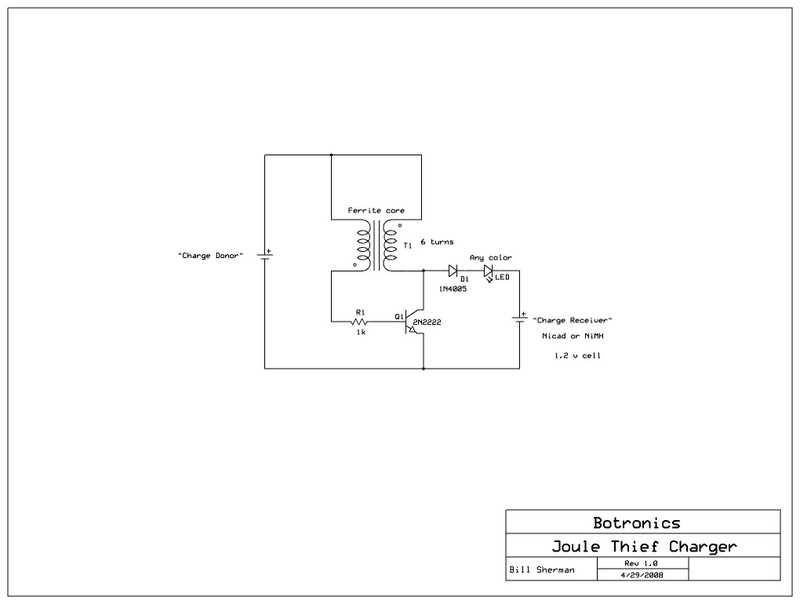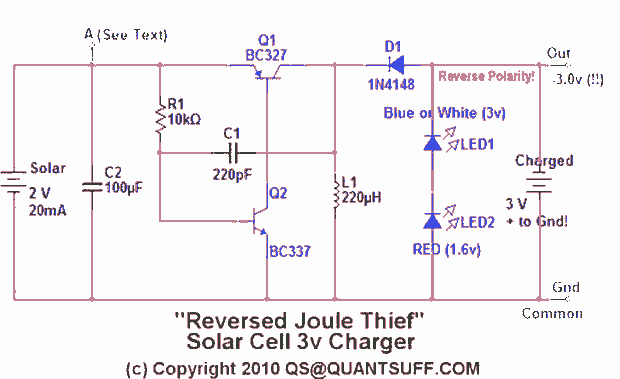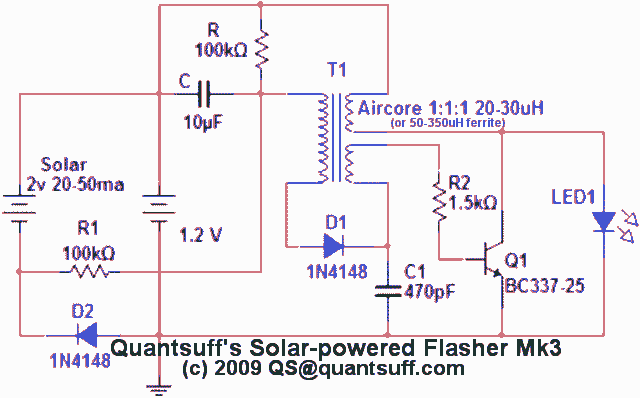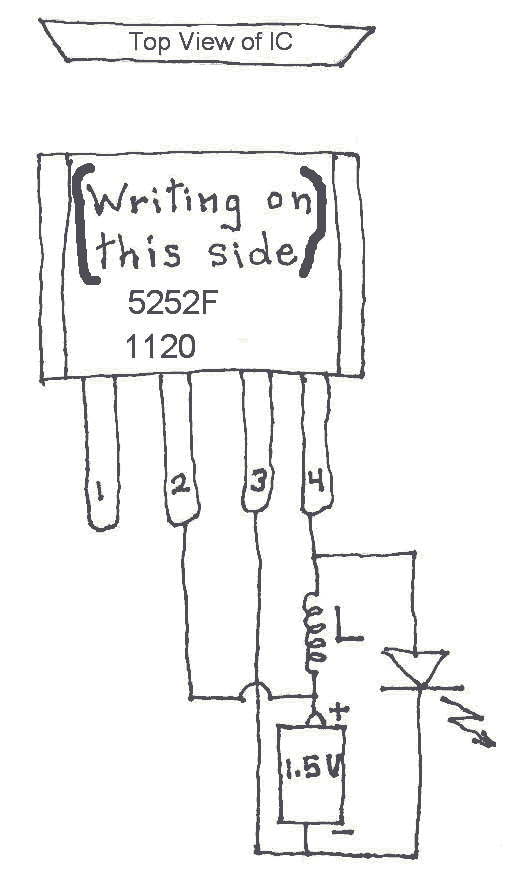
joule thief
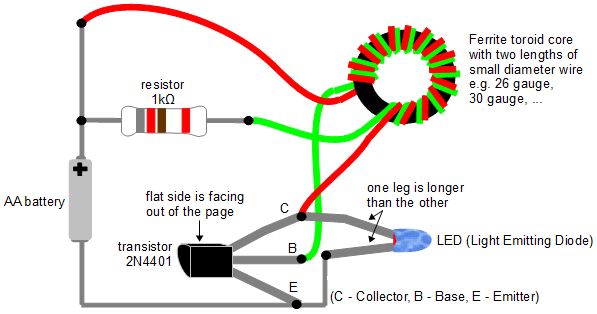
The Joule Thief is an electronic circuit designed to utilize batteries that are typically deemed dead. A battery is often labeled "dead" when it can no longer power a specific device. However, the underlying issue is that the battery voltage is insufficient for the device when used directly. The Joule Thief circuit modifies the voltage and current from the battery, elevating the voltage to a level that allows the device to operate continuously, albeit intermittently. For instance, an LED requires 1.85 volts, while the battery voltage may only be 1.27 volts. When processed through the Joule Thief circuit, the voltage can reach as high as 24 volts, as evidenced by oscilloscope readings. The LED may not receive constant power, but the intermittent supply is sufficient to keep it illuminated. Users have successfully powered compact fluorescent light bulbs (CFLs) by incorporating an additional coil of wire into the toroidal core, provided that the electronics from the CFL are removed, allowing the Joule Thief circuit to directly power the fluorescent tubes. The transistor's legs can be identified by the flat side of the transistor case. A variety of transistors can be utilized, including the 2N4401, NET123AP, BC547B, 2SC2500, BC337, and PN2222. The circuit diagram suggests using a 1-kilo-ohm resistor, although values ranging from 820 ohms to 2 kilo-ohms have also been successfully employed. A potentiometer may be used for adjustable resistance to optimize light output. The toroidal ferrite core can be salvaged from CFLs or other devices, with a typical configuration involving 13 turns for each wire using insulated 30-gauge and 26-gauge wire. The number of turns can be varied for experimentation. Proper attention to the circuit diagram is essential to ensure accurate wire connections.
The Joule Thief circuit operates on the principle of a self-oscillating boost converter, which is particularly effective in extracting energy from low-voltage batteries. The core component, a transistor, functions as a switch that rapidly turns on and off, creating a magnetic field in the toroidal core. When the magnetic field collapses, it induces a voltage in the secondary winding, boosting the output voltage to a usable level. The circuit typically consists of a few essential components: a transistor, a resistor, a toroidal ferrite core, and two coils of wire wound around the core.
To construct the circuit, the first step involves winding the wire around the toroidal core. The primary coil is connected to the collector of the transistor, while the secondary coil connects to the base through a resistor. This configuration allows feedback to the base, enabling the transistor to oscillate. The choice of resistor value influences the frequency of oscillation, thereby affecting the output voltage and power delivered to the load. In practice, experimenting with different resistor values can help achieve the desired brightness for the LED or CFL.
The LED or CFL is connected to the output of the circuit, which is where the boosted voltage is delivered. It is crucial to ensure that the CFL used has its internal electronics removed, allowing it to be powered directly by the Joule Thief circuit. This setup demonstrates the ability of the Joule Thief to efficiently utilize energy from batteries that would otherwise be discarded, showcasing its potential for sustainable energy solutions and DIY electronics projects.The joule thief is an electronic circuit that allows you to make use of batteries normally considered dead. A battery is often considered "dead" when it can`t power a particular device. But what`s really happening is that the battery voltage is no longer high enough for the device when it`s used directly.
The joule thief circuit massages the volta ge and current coming from the battery so that the voltage is high enough, for periods of time, for the device to work continuously. The LED in the above photo requires 1. 85 volts but as the photo below shows, the battery voltage is only 1. 27 volts. When run through the joule thief circuit, the voltage is as high as 24 volts, as shown in the oscilloscope output n the photo on the right.
Notice that the LED is not always getting power, but it`s often enough to keep it lit. People, including myself, have gotten it to run a compact fluorescent lightbulb (CFL) by adding an extra coil of wire to the toroid core. Also, the electronics has to be removed from the CFL so that the joule thief circuit is powering the fluorescent tubes directly.
i. e. it must be a gutted CFL. Transistor - The legs of the transistor can be determined by noticing that there`s a flat side to the transistor case. See the diagram above. A large number of transistors have been reported to work: 2N4401, NET123AP, BC547B, 2SC2500, BC337, PN2222, to name just a few.
Resistor - The diagram says use a 1 kilo ohm resistor but I`ve used an 820 ohm one just fine. I`ve also seen a 2 kilo ohm one in use. Use whatever works for you. You can also use a potentiometer (a variable resistor) so that you can easily adjust it to select the resistance that gives the best light. Toroid ferrite core - Some people have gotten these by opening up compact fluorescent lightbulbs (CFLs).
I took mine out of some device whose original function I don`t know. To get it working, my first one had just 13 turns for each wire and I used a 30 gauge wire and a 26 gauge wire. The wire must be insulated. A variety of number of turns will work. This is something you can play with. Look at the diagram carefully to determine where the wires connect to. 🔗 External reference
The Joule Thief circuit operates on the principle of a self-oscillating boost converter, which is particularly effective in extracting energy from low-voltage batteries. The core component, a transistor, functions as a switch that rapidly turns on and off, creating a magnetic field in the toroidal core. When the magnetic field collapses, it induces a voltage in the secondary winding, boosting the output voltage to a usable level. The circuit typically consists of a few essential components: a transistor, a resistor, a toroidal ferrite core, and two coils of wire wound around the core.
To construct the circuit, the first step involves winding the wire around the toroidal core. The primary coil is connected to the collector of the transistor, while the secondary coil connects to the base through a resistor. This configuration allows feedback to the base, enabling the transistor to oscillate. The choice of resistor value influences the frequency of oscillation, thereby affecting the output voltage and power delivered to the load. In practice, experimenting with different resistor values can help achieve the desired brightness for the LED or CFL.
The LED or CFL is connected to the output of the circuit, which is where the boosted voltage is delivered. It is crucial to ensure that the CFL used has its internal electronics removed, allowing it to be powered directly by the Joule Thief circuit. This setup demonstrates the ability of the Joule Thief to efficiently utilize energy from batteries that would otherwise be discarded, showcasing its potential for sustainable energy solutions and DIY electronics projects.The joule thief is an electronic circuit that allows you to make use of batteries normally considered dead. A battery is often considered "dead" when it can`t power a particular device. But what`s really happening is that the battery voltage is no longer high enough for the device when it`s used directly.
The joule thief circuit massages the volta ge and current coming from the battery so that the voltage is high enough, for periods of time, for the device to work continuously. The LED in the above photo requires 1. 85 volts but as the photo below shows, the battery voltage is only 1. 27 volts. When run through the joule thief circuit, the voltage is as high as 24 volts, as shown in the oscilloscope output n the photo on the right.
Notice that the LED is not always getting power, but it`s often enough to keep it lit. People, including myself, have gotten it to run a compact fluorescent lightbulb (CFL) by adding an extra coil of wire to the toroid core. Also, the electronics has to be removed from the CFL so that the joule thief circuit is powering the fluorescent tubes directly.
i. e. it must be a gutted CFL. Transistor - The legs of the transistor can be determined by noticing that there`s a flat side to the transistor case. See the diagram above. A large number of transistors have been reported to work: 2N4401, NET123AP, BC547B, 2SC2500, BC337, PN2222, to name just a few.
Resistor - The diagram says use a 1 kilo ohm resistor but I`ve used an 820 ohm one just fine. I`ve also seen a 2 kilo ohm one in use. Use whatever works for you. You can also use a potentiometer (a variable resistor) so that you can easily adjust it to select the resistance that gives the best light. Toroid ferrite core - Some people have gotten these by opening up compact fluorescent lightbulbs (CFLs).
I took mine out of some device whose original function I don`t know. To get it working, my first one had just 13 turns for each wire and I used a 30 gauge wire and a 26 gauge wire. The wire must be insulated. A variety of number of turns will work. This is something you can play with. Look at the diagram carefully to determine where the wires connect to. 🔗 External reference
